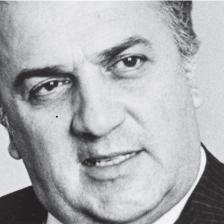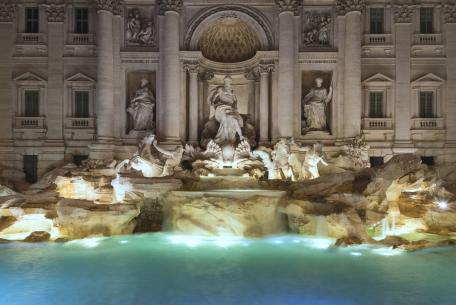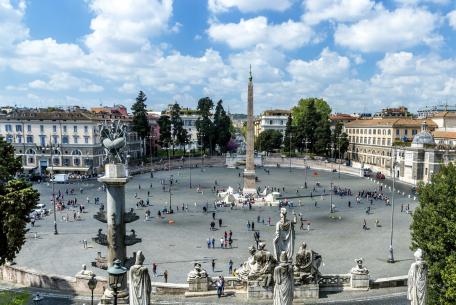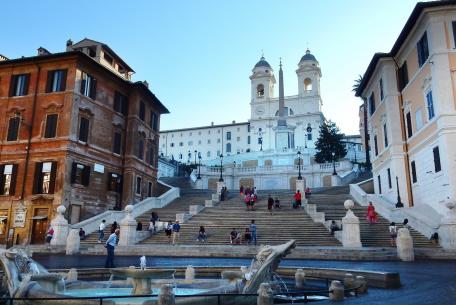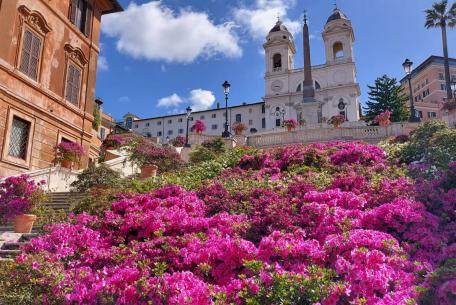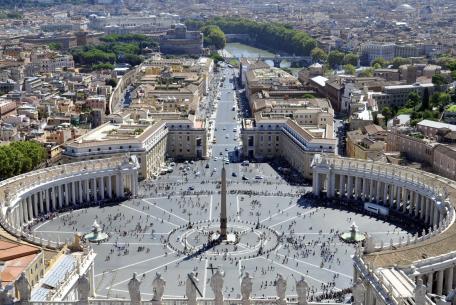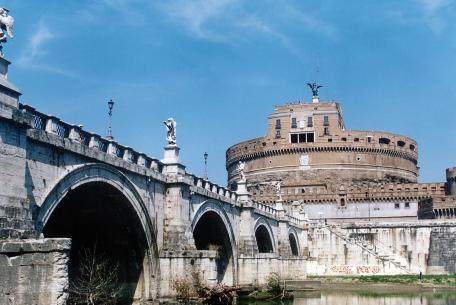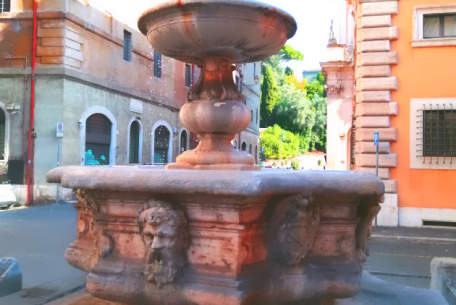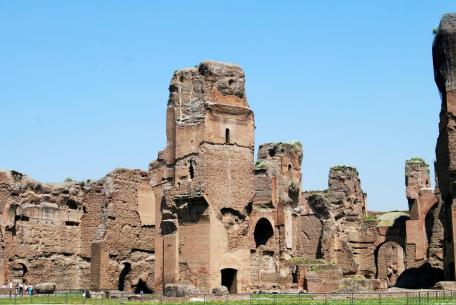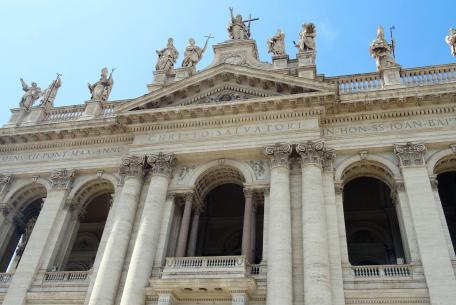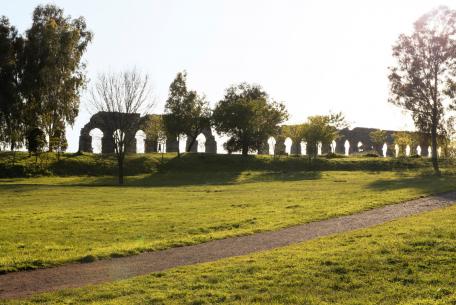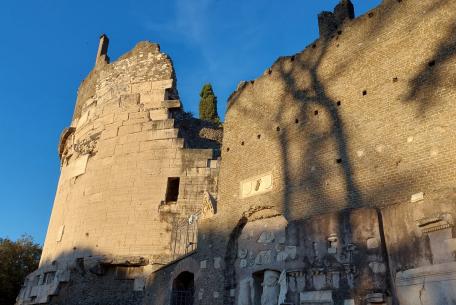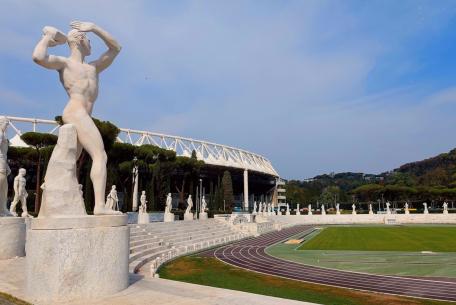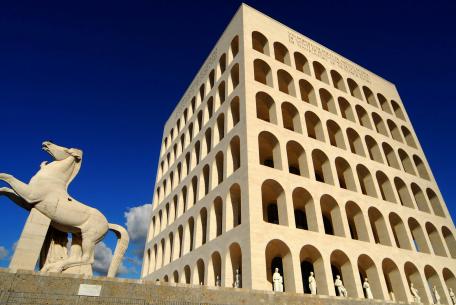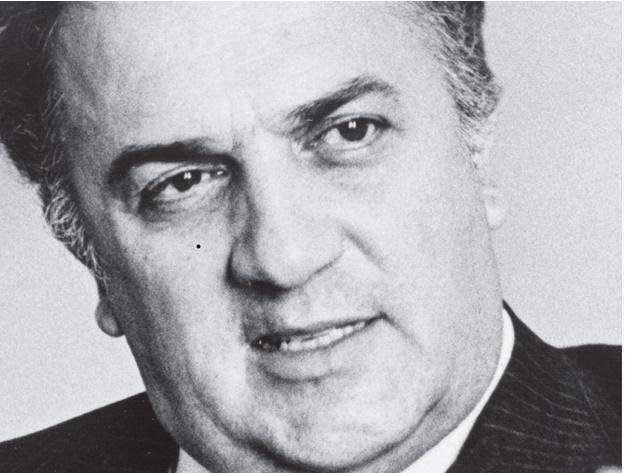
Federico Fellini was born in Rimini on 20 January 1920, son of Ida Barbiani, from Roma, and Urbano, a salesman native of Gambettola.
While still attending secondary school, the future film director begins to make a name for himself as a caricaturist: to promote films, the manager of Cinema Fulgor commissions him portraits of the stars. In early 1938 he begins working with the Domenica del Corriere newspaper, where several Fellini’s caricatures appear, as well as with the weekly Florence-based satirical publication 420.
In January 1939 he moves to Roma, on the pretext of enrolling in law school. In the Capital he joins the editorial office of Marc’Aurelio, a popular satirical periodical, where he becomes famous thanks to hundreds of sketches, all signed “Federico”.
He starts attending the theatre scene known as avanspettacolo and writes monologues for the comedian Aldo Fabrizi. He also cooperates on radio variety shows, where he meets the young actress Giulietta Masina (1921-1994). They will get married on 30th October 1943 and will have one child, who died just a month after his birth. Fellini begins to contribute to scripts for films by Fabrizi and others, soon gaining a name as a screenwriter. He works on Roma città aperta and then moves straight onto Paisà, striking up a productive friendship with Roberto Rossellini. He also decides to team up with the comedy writer Tullio Pinelli, of whom he will be forever fond. They become some of the film world’s most in-demand screenwriters, working for various directors including Pietro Germi and Alberto Lattuada. The latter has Fellini by his side as a co-director on Luci del varietà (1950), which they self-produce, racking up significant debts.
Fellini’s first film as a solo director Lo sceicco bianco (1952), also fares badly, but success comes with I vitelloni (1953), the winner of the Venice Film Festival’s Silver Lion and the launching pad for Alberto Sordi’s career. This is followed by La Strada (1954), starring Giulietta Masina, wich wins an Academy Award, the first in a series of films that will establish Fellini as one of cinema’s greats. His best-known works include Le notti di Cabiria (‘57, another Academy Award), La dolce vita (‘60, Palme d’Or at Cannes), 8½ (‘63, Academy Award), Fellini Satyricon (‘69), Roma (’72), Amarcord (’73, Academy Award), Il Casanova (’76), Prova d’orchestra (’79), Ginger e Fred (’85), Intervista (’87, Prize at Cannes, Golden Prize at the Moscow Film Festival), La voce della luna (’90). Fellini’s career is studded with tributes and accolades, including the Légion d’Honneur (’84) and the Japanese Praemium Imperiale (’90). In terms of Academy Awards, Fellini is one of the most successful directors ever, with five. The last one (a lifetime achievement award) arrives in 1993, just one month before his death in Roma on 31 October.
Bibliography source: www.federicofellini.it
FONTANA DI TREVI
La dolce vita (1960)
The spectacular baroque fountain plays host to the film most celebrated scene in which the legendary Anita Ekberg takes a dip.
PIAZZA DEL POPOLO
La dolce vita (1960)
Marcello (Marcello Mastroianni) and Maddalena (Anouk Aimée) pick up a prostitute in the car here to take her back home.
Roma (1972)
Fellini shows us the square briefly during the ending, as a group of bikers make the journey from Castel Sant’Angelo to the Colosseum.
VIA VENETO
La dolce vita (1960)
The street is one of the symbols of the film: every evening the movie stars meet at the Café de Paris.
Le notti di Cabiria (1957)
The sweet, naïve prostitute Cabiria (Giulietta Masina) heads here every day, mingling with other women whose rates are a lot higher than her own.
TRINITÀ DEI MONTI
Lo sceicco bianco (1952)
The newlyweds Ivan (Leopoldo Trieste) and Wanda (Brunella Bovo) stay at the Tre Fiori hotel on Via Sistina. The director’s eye lingers on a panorama of Roma with Trinità dei Monti in the foreground.
PIAZZA DI SPAGNA
Roma (1972)
A group of young hippies lounge on the Spanish Steps, swimming in the Barcaccia Fountain and playing music.
VIA XIV MAGGIO (Quirinale)
Lo sceicco bianco (1952)
In this street is located the studio where the newlywed Wanda (Brunella Bovo) is supposed to meet the hero of her dreams, unbeknownst to her husband.
STAZIONE TERMINI
Lo sceicco bianco (1952)
I vitelloni (1953)
Le notti di Cabiria (1957)
Roma (1972)
Roma’s largest station features often in Fellini’s films, always as a symbol of rebirth.
PIAZZA SAN PIETRO
Lo sceicco bianco (1952)
The square plays host to the reconciliation between Ivan (Leopoldo Trieste) and Wanda (Brunella Bovo) after her getaway in the hope of meeting the hero of her dreams.
La dolce vita (1960)
The film opens with a panoramic shot of the square, where Marcello (Marcello Mastroianni) is flying in a helicopter transporting a statue of Christ. We see the square again later when Marcello meets the beautiful Swedish star Sylvia (Anita Ekberg) for the first time and climbs to the top of Michelangelo’s dome with her.
CASTEL SANT’ANGELO
Lo sceicco bianco (1952)
Wanda (Brunella Bovo), planning to throw herself into the Tiber due to the shame of almost having betrayed her husband Ivan (Leopoldo Trieste), arrives underneath the Sant’Angelo Bridge, but the water is too low and all she manages is a laughable fall.
Roma (1972)
The starting point for the wonderful nighttime ride by a gang of bikers, which ends up at the Colosseum.
PIAZZA CAMPITELLI
Lo sceicco bianco (1952)
The newlywed Ivan (Leopoldo Trieste), feeling down and disconsolate after being abandoned by his wife Wanda (Brunella Bovo), sits on a fountain in Piazza Campitelli, where two prostitutes try to comfort him.
TERME DI CARACALLA
Le notti di Cabiria (1957)
The workplace of the childlike prostitute Cabiria (Giulietta Masina).
La dolce vita (1960)
The spot, reproducing the famous Roman baths, is the setting for Marcello (Marcello Mastroianni) and the Swedish star Sylvia (Anita Ekberg) to dance and get to know each other.
SAN GIOVANNI IN LATERANO
Roma (1972)
The setting for a scene shot as night gives way to sunrise, where a shepherd puts a herd of sheep out to graze as in a postcard version of Roma, in which San Giovanni still lies on the outskirts.
PARCO DEGLI ACQUEDOTTI
La dolce vita (1960)
The film opens with a panoramic shot of Parco degli Acquedotti. Here Marcello (Marcello Mastroianni) starts his helicopter tour.
MAUSOLEO DI CECILIA METELLA
Roma (1972)
For a fleeting moment at the beginning of the film, a fragment of the tomb can be seen. A massive and savage prostitute, who becomes the symbol of the film, is standing among busts and fragments of Roman columns.
FORO ITALICO
Roma (1972)
The main film character, from Rimini, Fellini himself, goes as a child with his family to the cinema. Here he watches a newsreel showing a group of athletes ready to do the Roman salute, after jumping into the fire ring at the Foro Italico Stadium.
EUR
Boccaccio 70 (1962)
Fellini, who was very fond of this district, depicts it for the first time in this film. His favourite areas of Eur are the Palazzo della Civiltà del Lavoro, better known as the Square Colosseum, the doors of the Palazzo degli Uffici and Laghetto (The lake).
CINECITTÀ STUDIOS
During its 80-year history, more than 3,000 films have been created at these film studios and 51 of them have won Academy Awards. Cinecittà has provided the setting for masterpieces that have thrilled generations of viewers. Teatro 5 was Federico Fellini’s kingdom – he shot several of his masterpieces there and it still holds the number one spot as the largest sound stage in Europe today.
CINECITTÀ SHOWS OFF
A permanent exhibition through Cinecittà and the sets of Ancient Roma, the Temple of Jerusalem and Prop Storage Room 107. An entire room designed by major cinema set designers is dedicated to the master himself, Federico Fellini.
For information and tours: cinecittasimostra.it
To start your walk you can download the itinerary Fellini's locations
 Condividi
Condividi












































